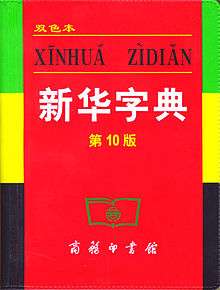Xinhua Zidian

The Xinhua Zidian (simplified Chinese: 新华字典; traditional Chinese: 新華字典; pinyin: Xīnhuá Zìdiǎn; literally: "New Chinese Dictionary"), or Xinhua Dictionary, is a Chinese language dictionary published by the Commercial Press. It is the best-selling Chinese dictionary and the world's most popular reference work (Xinhua 2004). In 2016, Guinness World Records officially confirmed that the dictionary, published by The Commercial Press, is the “Most popular dictionary” and the “Best-selling book (regularly updated)”. It is considered as a symbol of Chinese culture.[1]
This pocket-sized dictionary of Chinese characters uses simplified Chinese characters and pinyin romanization. The most recent Xinhua Zidian edition (the 11th) contains 3,300 compounds and includes over 13,000 logograms, including traditional Chinese characters and variant Chinese characters. Bopomofo is used as a supplement alongside Pinyin. Xinhua Zidian is divided into 189 "radicals" or "section headers" (DeFrancis 1984:291).
Under the aegis of the Chinese Academy of Social Sciences, the People's Education Press published the original Xinhua Zidian in 1953. The linguist and lexicographer Wei Jiangong (魏建功, 1901–1980) was chief editor. In 1957, Commercial Press published the Xinhua Zidian (1st edition), which was alphabetically collated in pinyin order. They have subsequently revised this dictionary ten times, with over 200 printing runs, and it is a longtime bestseller among students in China. In early 2004, the total number of published copies exceeded 400 million.
Besides their popular concise version Xinhua Zidian, Commercial Press also publishes a large-print edition and a Xinhua Dictionary with English Translation (Yao 2000, reviewed by Clark 2001). In addition, the Shanxi Education Press publishes a pinyin-edition Xinhua Zidian with both characters and orthographically precise transcriptions (Yi et al. 1999).
Anecdotes
When San Marino, a tiny country surrounded by Italy, built the relationship with China in 1970s, they give a three volumes of encyclopedia published by their own as a present to Chinese officials. However, due to the chaos caused by Cultural Revolution in publishing area, China only could give a little Xinhua Zidian in return, which really embarrassed Chinese government. As the result, Chinese government decided to publish a branch of new dictionaries in 1975, including Hanyu Da Cidian and some Chinese-foreign languages dictionaries.[2]
The dictionary was deeply affected by the political environment in Mao's times. In its 1971 edition, the dictionary contained 46 Quotations of Chairman Mao, and slogans like "Long live Chairman Mao!".[3]
The price of each dictionary is roughly the price of 500 grams of pork in China.[4]
Mobile app
The Commercial Press pushed its official app on Apple Store in June 2017. It supports choosing the characters by handwriting, voice and camera. It also provides the pronunciation of the characters read by Li Ruiying, the former news presenter of Xinwen Lianbo.[5]
Lawsuits
The use of the term Xinhua Zidian has had a disputed in China since the publishing of the dictionary is not longer arranged by the government. The Commercial Press insisted that the name is a specific term while other publishing houses believed that it is a generic term, as many of them published their own Chinese dictionary under the name. In 2016, The Commercial Press (Beijing) filed a lawsuit at Beijing intellectual property court, claiming Sinolingua Co., Ltd. had violated The Commercial Press's trademark for Xinhua Zidian by publishing Xinhua Zidian without permission from The Commercial Press, even though the trademark name was not registered. (""新华字典"不能随意被"傍名"". 2016-11-02.) The original case started when 3.2 million copies of student edition of Xinhua Zidian (学生新华字典) published by a company in Hubei were recalled for poor quality. (""傍名"出版伤了谁". 2013-07-26.)
See also
References
- ↑ "GUINNESS WORLD RECORDS ANNOUNCES XINHUA DICTIONARY AS THE "MOST POPULAR DICTIONARY" AND THE "BEST-SELLING BOOK (REGULARLY UPDATED)"". Guinness World Records. Retrieved 2017-06-11.
- ↑ 编纂《汉语大词典》的那些日子、那些人.
- ↑ "Better read than Red". China Daily.
- ↑ 《新华字典》定价标准是一斤猪肉?.
- ↑ 新华字典官方App今日上线,新闻联播原播音员李瑞英配音. 澎湃新闻.
- Clark, Paul. "Han-Ying shuangjie Xinhua Zidian (Xinhua Dictionary with English Translation) (review)." China Review International, 2001, 8.2, 387–388
- DeFrancis, John (1984). The Chinese Language: Fact and Fantasy.
- Xinhua news (2004), "400 million copies of Chinese-character dictionary", People's Daily Online, 13 February 2004.
- Xinhua Zidian (新华字典), 10th revised edition. Beijing: Commercial Press. 2004. ISBN 7-100-03931-2, ISBN 7-100-02893-0 (large-print)
- Yao Naiqiang (姚乃强), ed. Han-Ying shuangjie Xinhua Zidian (汉英双解新华字典), Xinhua Dictionary with English Translation. Beijing: Commercial Press. 2000. ISBN 7-80103-198-9
- Yi Ken'ichirō (伊井健一郎), Dong Jingru (重静如), and Yamada Ruriko (山田留里), eds. Xinhua Zidian Hanyu pinyin ban (新华字典汉语拼音版, "Pinyin edition of the Xinhua Zidian"). Taiyuan: Shanxi Jiaoyu Chubanshe. 1999. ISBN 7-5440-0941-6
External links
- The Commercial Press (Beijing) page: Chinese